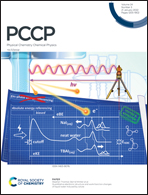Binding mechanism of inhibitors to SARS-CoV-2 main protease deciphered by multiple replica molecular dynamics simulations†
Abstract
The outbreak caused by SARS-CoV-2 has received extensive worldwide attention. As the main protease (Mpro) in SARS-CoV-2 has no human homologues, it is feasible to reduce the possibility of targeting the host protein by accidental drugs. Thus, Mpro has been an attractive target of efficient drug design for anti-SARS-CoV-2 treatment. In this work, multiple replica molecular dynamics (MRMD) simulations, principal component analysis (PCA), free energy landscapes (FELs), and the molecular mechanics-generalized Born surface area (MM-GBSA) method were integrated together to decipher the binding mechanism of four inhibitors masitinib, O6K, FJC and GQU to Mpro. The results indicate that the binding of four inhibitors clearly affects the structural flexibility and internal dynamics of Mpro along with dihedral angle changes of key residues. The analysis of FELs unveils that the stability in the relative orientation and geometric position of inhibitors to Mpro is favorable for inhibitor binding. Residue-based free energy decomposition reveals that the inhibitor–Mpro interaction networks involving hydrogen bonding interactions and hydrophobic interactions provide significant information for the design of potent inhibitors against Mpro. The hot spot residues including H41, M49, F140, N142, G143, C145, H163, H164, M165, E166 and Q189 identified by computational alanine scanning are considered as reliable targets of clinically available inhibitors inhibiting the activities of Mpro.



 Please wait while we load your content...
Please wait while we load your content...